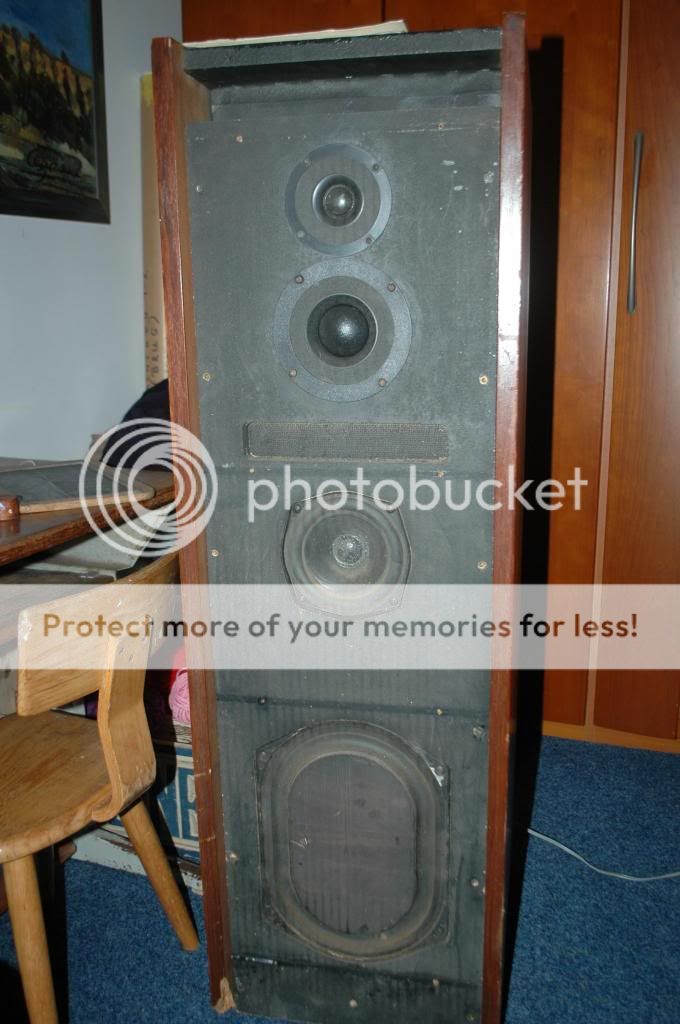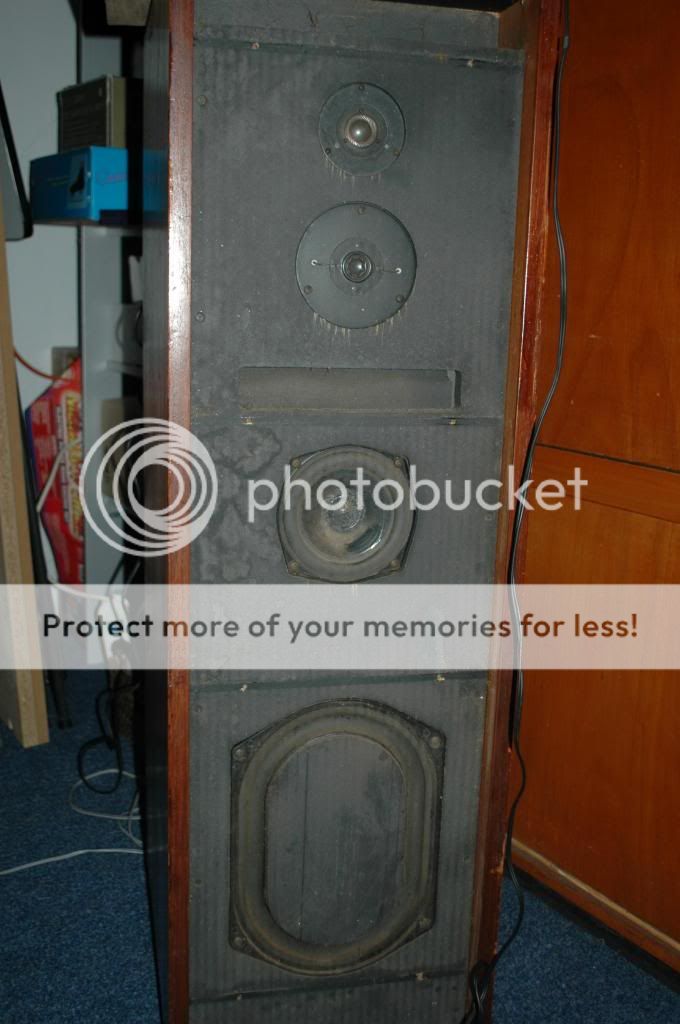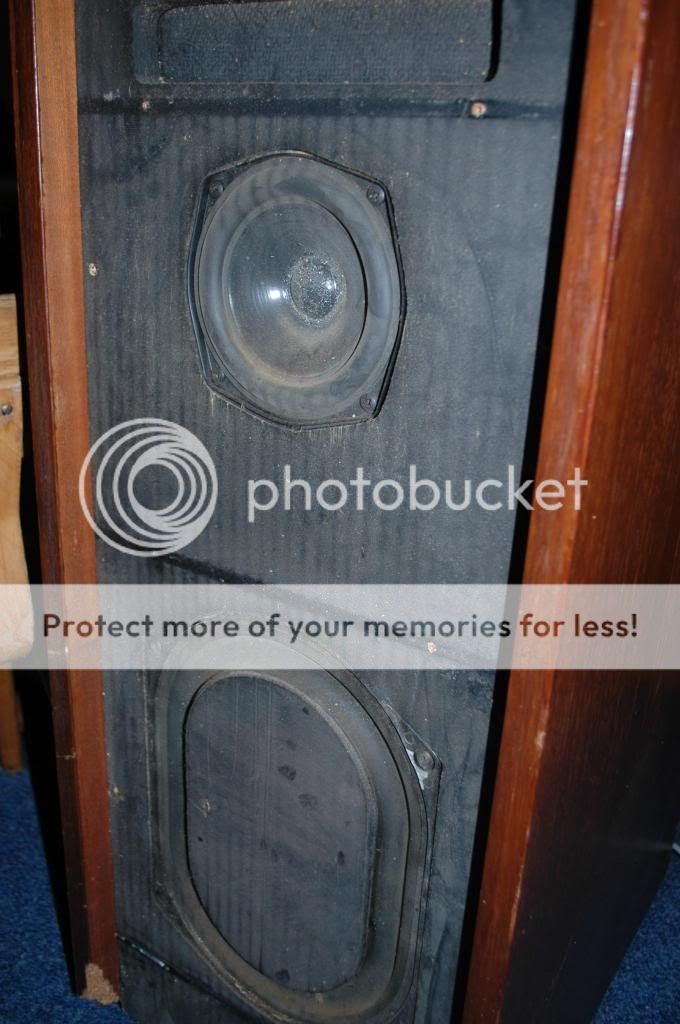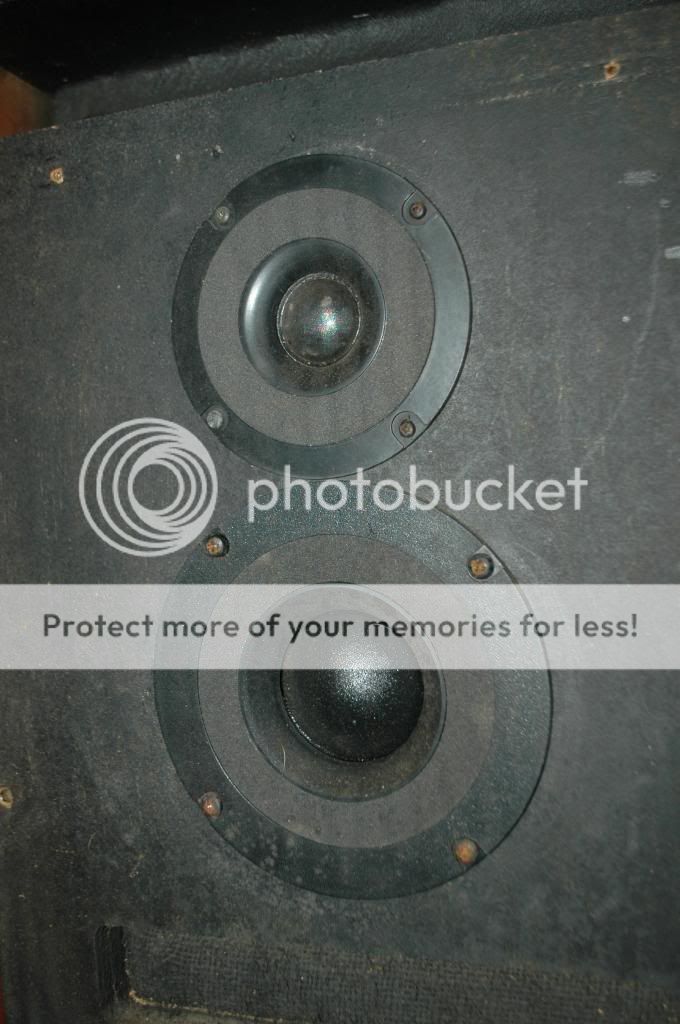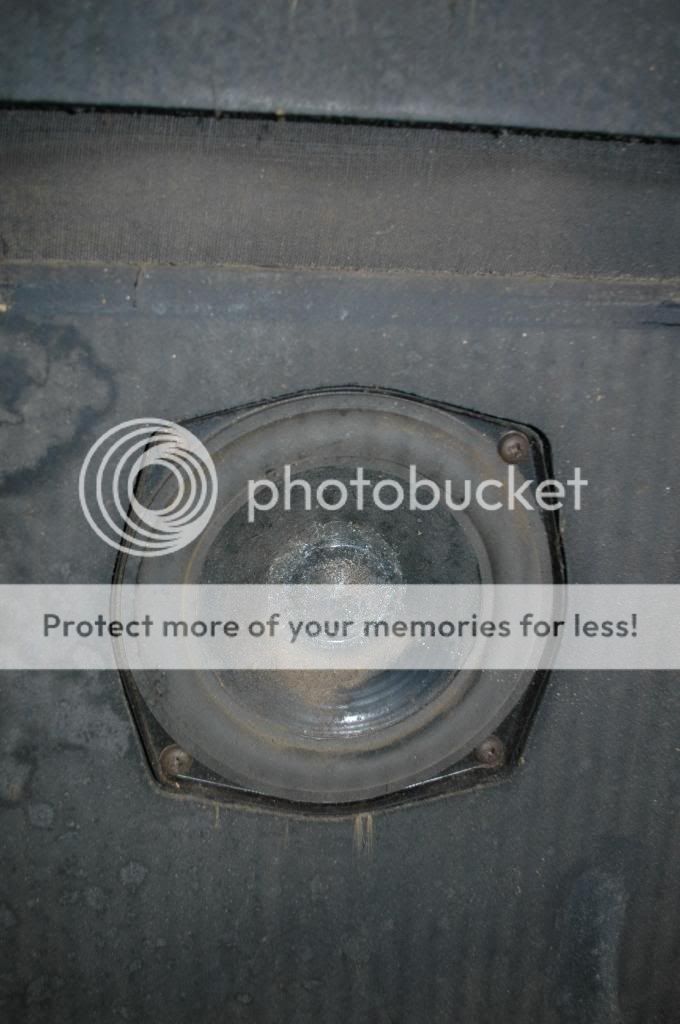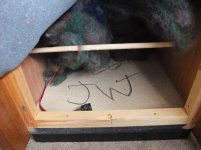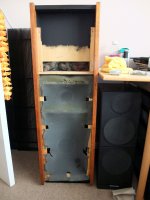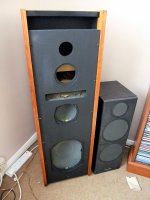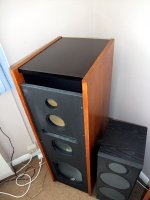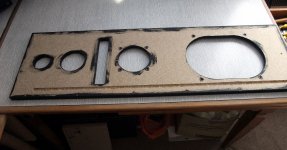Hello,
I have two sets of TL speakers which both need work. I would like to get your opinions what is the best approach.
Cambridge Audio R50
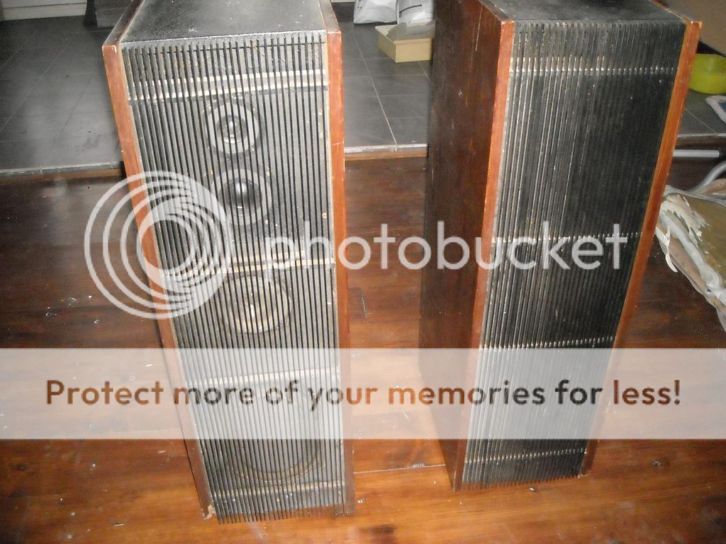
As you can see these speakers are in bad shape. Also one unit has replacement for the T27 and Coles from Monarch (DT105 and DM135).
The filter needs to be recapped after 40 years
Rogers Monitor (RM)
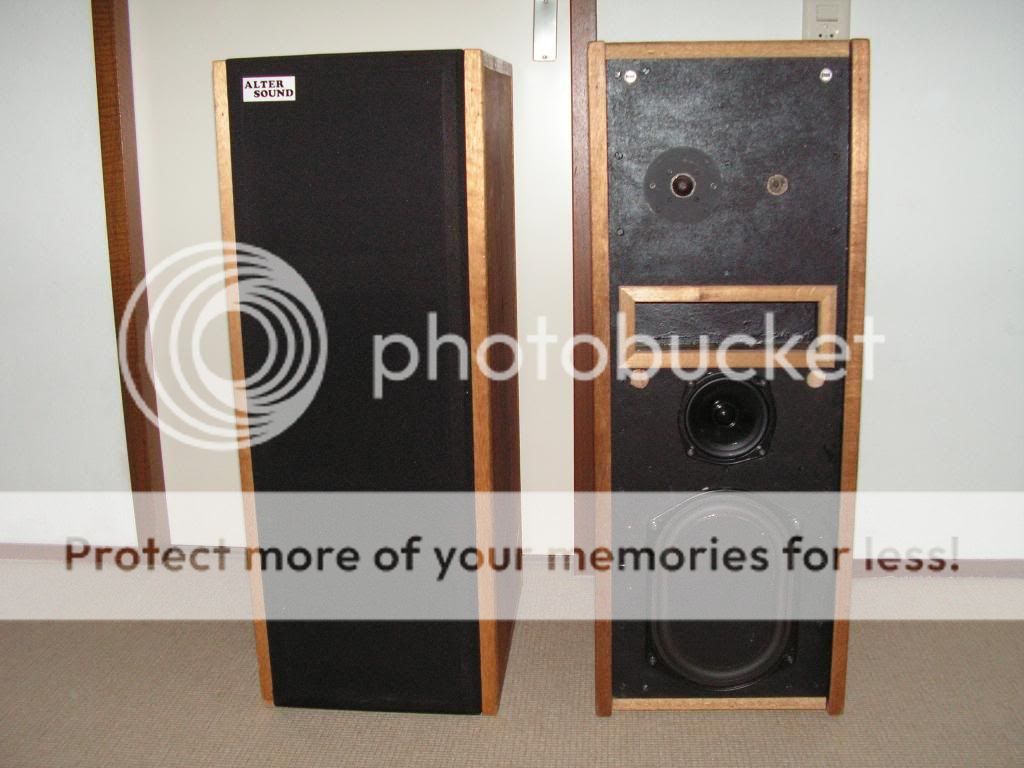
These are visual in good shape and sound OK but need to be recapped as well and possibly need a new filter.
The units are Kef B139 and B110 and Audax HD100D25
Here are the options I consider:
1) R50 replace the Monarch with Coles (replacement) and T27 (from ebay). Recap the filter. Cleanup the enclosure and use the R50 and sell the RMs.
2) R50 replace the T27 and the Monarch TM135 with the Audax HD100D25. Recap the filter and sell the remaining Kef units on eBay
3) RM replace the filter with the filter from the R50 and recap and throw out the R50.
What are your opinions on the R50 vs RM? And what approach would you take. Or what alternatives can you think of?
Thanks,
Frank
I have two sets of TL speakers which both need work. I would like to get your opinions what is the best approach.
Cambridge Audio R50

As you can see these speakers are in bad shape. Also one unit has replacement for the T27 and Coles from Monarch (DT105 and DM135).
The filter needs to be recapped after 40 years
Rogers Monitor (RM)

These are visual in good shape and sound OK but need to be recapped as well and possibly need a new filter.
The units are Kef B139 and B110 and Audax HD100D25
Here are the options I consider:
1) R50 replace the Monarch with Coles (replacement) and T27 (from ebay). Recap the filter. Cleanup the enclosure and use the R50 and sell the RMs.
2) R50 replace the T27 and the Monarch TM135 with the Audax HD100D25. Recap the filter and sell the remaining Kef units on eBay
3) RM replace the filter with the filter from the R50 and recap and throw out the R50.
What are your opinions on the R50 vs RM? And what approach would you take. Or what alternatives can you think of?
Thanks,
Frank
Last edited:
Frank,
The 2 lines are very similar... the Cambridge is the Webb TL, and (i'm guessing) the Rogers Monitor is the Pro9TL. Without going as far as building new cabinets*, i'd pull the B110, T27, and ST out of the Pro9TL, flip it upside down, install a Fostex FF85wk or Mark Audio Alpair 6.2M, and biamp.
*(4 B139s are screamng, push-push TL at me)
Can you post an R50 pic without the grills? And a close up of all but the B139s.
dave
The 2 lines are very similar... the Cambridge is the Webb TL, and (i'm guessing) the Rogers Monitor is the Pro9TL. Without going as far as building new cabinets*, i'd pull the B110, T27, and ST out of the Pro9TL, flip it upside down, install a Fostex FF85wk or Mark Audio Alpair 6.2M, and biamp.
*(4 B139s are screamng, push-push TL at me)
Can you post an R50 pic without the grills? And a close up of all but the B139s.
dave
Cambridge R50
I've got two I made 20 years ago with Falcon crossovers and 4001G supertweeters. Unfortunately I'd lost the page from the original Webb article with the front panel spacings so I did it by guesswork from a photo.
Does any kind person have the page or could measure one they've got. Webb says the spacing between the treble units is critical so the distance between centres would be particularly helpful. In fact all I really need is spacings between the four driver centres.
I've got most of Webb's article marked 1/75 so if I can help anyone.
I used long fibre wool which caused moth hell in my home. I''ve replaced it with wadding from IKEA pillows - very cheap.
I left out various bits of strutting and did not underseal or veneer so I'm doing that plus if I can get the measurements I'll make an accurate front panel. I fancy zebrawood veneer but what a price.
They sound pretty good to me!
I've got two I made 20 years ago with Falcon crossovers and 4001G supertweeters. Unfortunately I'd lost the page from the original Webb article with the front panel spacings so I did it by guesswork from a photo.
Does any kind person have the page or could measure one they've got. Webb says the spacing between the treble units is critical so the distance between centres would be particularly helpful. In fact all I really need is spacings between the four driver centres.
I've got most of Webb's article marked 1/75 so if I can help anyone.
I used long fibre wool which caused moth hell in my home. I''ve replaced it with wadding from IKEA pillows - very cheap.
I left out various bits of strutting and did not underseal or veneer so I'm doing that plus if I can get the measurements I'll make an accurate front panel. I fancy zebrawood veneer but what a price.
They sound pretty good to me!
I have the speaker builder version of the Webb article, but it is paper so the search could be long.
Jerry at Falcon has said he is planning to post the original article in his archives... a poke might push that forward.
dave
Thank you!
I've mailed Falcon.
I consider myself prodded 
http://www.falconacoustics.co.uk/downloads/Webb%20R50%20Construction.pdf
Jerry
http://www.falconacoustics.co.uk/downloads/Webb%20R50%20Construction.pdf
Jerry
.
Hi there
I joined your Forum , after looking for R50 information, concerning what amplifier to use .(I am currently driving my R50 copies with an Inca Tech - The Claymore) , and came across this thread
I have a copy of ,
Hi-Fi Answers - Transmission Line Monitor Speaker Build by C.J Rogers.
Badger Sound Services - Speaker Constructor's Service , with the same build , slightly better quality print .
Cambridge Audio Loudspeakers - original R40 , R50 brochure .
B139, B110 and T27 installation drawings .
And an 'A1' drawing of the speaker plan . (might be difficult to scan this one) .
If this is what you looking for ,
I will scan it all , and put it on my web page . (fingers crossed )
)
Thanx Dave.
.
Hi there
I joined your Forum , after looking for R50 information, concerning what amplifier to use .(I am currently driving my R50 copies with an Inca Tech - The Claymore) , and came across this thread
I've got two I made 20 years ago with Falcon crossovers and 4001G supertweeters. Unfortunately I'd lost the page from the original Webb article with the front panel spacings so I did it by guesswork from a photo.
Does any kind person have the page or could measure one they've got. Webb says the spacing between the treble units is critical so the distance between centres would be particularly helpful. In fact all I really need is spacings between the four driver centres.
I've got most of Webb's article marked 1/75 so if I can help anyone.
I have a copy of ,
Hi-Fi Answers - Transmission Line Monitor Speaker Build by C.J Rogers.
Badger Sound Services - Speaker Constructor's Service , with the same build , slightly better quality print .
Cambridge Audio Loudspeakers - original R40 , R50 brochure .
B139, B110 and T27 installation drawings .
And an 'A1' drawing of the speaker plan . (might be difficult to scan this one) .
If this is what you looking for ,
I will scan it all , and put it on my web page . (fingers crossed
Thanx Dave.
.
First of all i am only trying to help!
I was fortunate at the age of 24yrs in 1972 working at a shopfitting company in Sittingbourne Kent UK was able to cut and assemble these R40 & R50 speaker cabinets for the Cambridge loudspeaker company.
I am now 65yrs and 41yrs further on i had to wait to only just obtain my first pair of original R50`s.
When each person assembled these speakers when finished there initials were written inside on the bottom and mine have JW and John worked on the bench next to myself so i would of helped him take these speakers to our large press when assembly was complete and the glue was all wet ready for it to cure which took about 2 1/2 hours, the press was right next to our heater so curing in all weathers was no problem.
My initials are KG so some of you may have those written on the inside of your own speakers cabinets.
The drawings in the .pdf ones do have some errors other than that pointed out. The Major one is the fact that a groove 12mm x 5mm deep and being machined from 75mm down from the top of the front baffle plate on the right side looking at the front extends to within 12mm of the bottom so the air does not escape! The groove is 22mm in from the edge because of the softwood fixing battens.
This groove is to easily enable the connecting wires from all the speakers and the crossover in the top void to escape down to the base void and to the rear of the cabinet for external connection. The whole front baffle plate with speakers can be assembled on the bench and when soldering completed the groove has a sealing putty like substance pressed over it so when assembling the front completed baffle to the cabinet the putty seals the groove with it`s wires where it crosses the dividing panels for the different voids thus keeping them airtight to one another.
This is an easier and more professional way than drilling holes for wires into each void and aralditeing each hole. It also enables all to be completed on the bench.
The Super Tweeter recess hole in the front baffle is 3" and NOT 4"
The 2" x 1 1/2" softwood batten in the bass void goes front side to side and is not a "T" shape with part going to the rear of the cabinet. We used to use this to lift with one hand and steadying the top of the cabinet with the other when removing them from the press.
I am at the moment renovating my R50`s back to original as far as possible.
I have replaced the end edges veneer with iron on Teak wood veneer instead of contact glue and plain teak veneer. To give the aged look or Patina stain the new teak with Georgian Medium Oak stain and apply some French polish and wire wool and wax polish after hardening. The finish on the side panels was always Shellac which was sprayed on to give the French polish look.
I hope i have been some help to those thinking of making there own speakers from those very fine drawings. Of course time moves on but this is how they were constructed from 1972 to 1976 at our factory.
Keith Graham
I was fortunate at the age of 24yrs in 1972 working at a shopfitting company in Sittingbourne Kent UK was able to cut and assemble these R40 & R50 speaker cabinets for the Cambridge loudspeaker company.
I am now 65yrs and 41yrs further on i had to wait to only just obtain my first pair of original R50`s.
When each person assembled these speakers when finished there initials were written inside on the bottom and mine have JW and John worked on the bench next to myself so i would of helped him take these speakers to our large press when assembly was complete and the glue was all wet ready for it to cure which took about 2 1/2 hours, the press was right next to our heater so curing in all weathers was no problem.
My initials are KG so some of you may have those written on the inside of your own speakers cabinets.
The drawings in the .pdf ones do have some errors other than that pointed out. The Major one is the fact that a groove 12mm x 5mm deep and being machined from 75mm down from the top of the front baffle plate on the right side looking at the front extends to within 12mm of the bottom so the air does not escape! The groove is 22mm in from the edge because of the softwood fixing battens.
This groove is to easily enable the connecting wires from all the speakers and the crossover in the top void to escape down to the base void and to the rear of the cabinet for external connection. The whole front baffle plate with speakers can be assembled on the bench and when soldering completed the groove has a sealing putty like substance pressed over it so when assembling the front completed baffle to the cabinet the putty seals the groove with it`s wires where it crosses the dividing panels for the different voids thus keeping them airtight to one another.
This is an easier and more professional way than drilling holes for wires into each void and aralditeing each hole. It also enables all to be completed on the bench.
The Super Tweeter recess hole in the front baffle is 3" and NOT 4"
The 2" x 1 1/2" softwood batten in the bass void goes front side to side and is not a "T" shape with part going to the rear of the cabinet. We used to use this to lift with one hand and steadying the top of the cabinet with the other when removing them from the press.
I am at the moment renovating my R50`s back to original as far as possible.
I have replaced the end edges veneer with iron on Teak wood veneer instead of contact glue and plain teak veneer. To give the aged look or Patina stain the new teak with Georgian Medium Oak stain and apply some French polish and wire wool and wax polish after hardening. The finish on the side panels was always Shellac which was sprayed on to give the French polish look.
I hope i have been some help to those thinking of making there own speakers from those very fine drawings. Of course time moves on but this is how they were constructed from 1972 to 1976 at our factory.
Keith Graham
Attachments
Last edited:
Cambridge R50 Repair
Great to see another R50 in bits.
I am also starting to rebuild a pair but the campartment filling has been moved about, if you haven't already take a look at my thread "Cambridge R50/Ex Baobab speakers".
I am trying to find out how all the filling is suposed to fit correctly, apart from the stuff shown in my pics there is a roll and sheet of what looks like carpet underlay. Have you taken the foam off the front of yours and if so can you help?
Great to see another R50 in bits.
I am also starting to rebuild a pair but the campartment filling has been moved about, if you haven't already take a look at my thread "Cambridge R50/Ex Baobab speakers".
I am trying to find out how all the filling is suposed to fit correctly, apart from the stuff shown in my pics there is a roll and sheet of what looks like carpet underlay. Have you taken the foam off the front of yours and if so can you help?
Hi ParalabFan
I have put the pictures of my R50 repair on my site at: Cambridge Audio R50
Please have a look if this can help
I have put the pictures of my R50 repair on my site at: Cambridge Audio R50
Please have a look if this can help
The bass chamber was fitted with longhair wool like "Dr. Bailey's longhair wool" that can be found at remo.nl
In the B110 chamber my speaker indeed has the foam plug.
I ordered a set of replacement filters from falcon audio which I will receive this week. I am really curious about the effect it will have on the sound.
In the B110 chamber my speaker indeed has the foam plug.
I ordered a set of replacement filters from falcon audio which I will receive this week. I am really curious about the effect it will have on the sound.
Last edited:
The bass chamber was fitted with longhair wool like "Dr. Bailey's longhair wool" that can be found at remo.nl
In the B110 chamber my speaker indeed has the foam plug.
I ordered a set of replacement filters from falcon audio which I will receive this week. I am really curious about the effect it will have on the sound.
I would be intersted to hear the results as I have just built the F6M crossover and until I have finished the cabinets and obtained all the speakers I won't be able to hear them.
- Status
- This old topic is closed. If you want to reopen this topic, contact a moderator using the "Report Post" button.
- Home
- Loudspeakers
- Multi-Way
- Cambridge Audio R50 and Rogers Monitor repair
